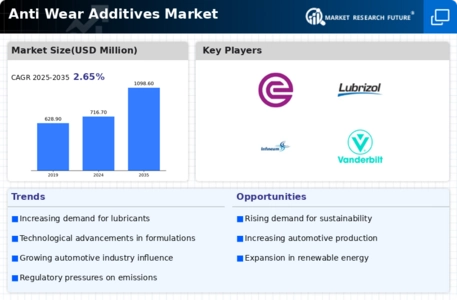Market Analysis
In-depth Analysis of Anti Wear Additives Market Industry Landscape
The demand for hydraulic fluid has risen significantly in recent years, mainly driven by the thriving automotive industry. This trend is expected to continue in the coming years as the automotive sector continues to grow.
The automotive industry has experienced substantial growth in both consumer and commercial automobile production. Hydraulic fluids play a crucial role in this industry, being used not only during manufacturing but also for lubrication purposes. These fluids provide essential benefits such as corrosion protection, fire resistance, and heat treatment during the production of automobiles. With a consistent increase in demand for both commercial and consumer vehicles worldwide, the automotive industry has witnessed remarkable growth, leading to a substantial need for hydraulic fluids for various purposes.
The demand for hydraulic fluid is anticipated to witness a significant rise in the automotive industry during the forecast period. One of the contributing factors is the continuous growth in automobile production. Asia Pacific stands out as a prominent region in automobile production, contributing to the largest market share for hydraulic fluid consumption. The region experiences high numbers of vehicles produced annually, further boosting the demand for hydraulic fluids in the automotive sector.
A noteworthy development in the hydraulic fluid market is the emergence of bio-based hydraulic fluids as a new driving force. This shift is influenced by stringent emission guidelines and regulatory frameworks. The demand for bio-based hydraulic fluids has been increasing rapidly due to these regulations, and this trend is expected to persist in the forecast period. Bio-based hydraulic fluids are gaining popularity, especially in industries like mining, forestry, and agriculture, where environmental concerns are prominent. These fluids are considered a favorable option due to their lower environmental impact.
In recent years, bio-based hydraulic fluids have gained significant traction globally, with a considerable increase in consumption. The benefits associated with these fluids, along with the growing emphasis on environmental sustainability, have positioned them as a crucial market driver. This shift towards bio-based hydraulic fluids aligns with the global efforts to adopt more eco-friendly practices in various industries.
In conclusion, the flourishing automotive industry has been a key factor in driving the demand for hydraulic fluids, and this trend is expected to continue in the foreseeable future. The rise of bio-based hydraulic fluids, influenced by environmental concerns and regulatory measures, adds a new dimension to the market, making it a key driver with significant potential for growth. The consumption of bio-based hydraulic fluids is on the rise, particularly in industries where sustainability is a priority, marking a positive shift towards more environmentally friendly practices in the hydraulic fluid market.







Leave a Comment